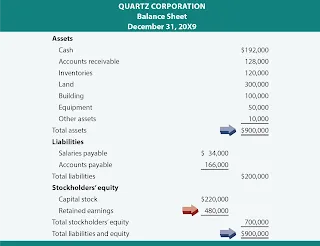Retained Earnings On Balance Sheet
The retained earnings account on the balance sheet represents the amount of money a company keeps for itself instead of sharing it to shareholders or investors as dividends. Net profit and dividends are the items that can increase or decrease retained earnings of a company. Retained earnings are reduced by losses and dividend payments, while profits increase retained earnings.
How To Calculate Retained Earnings
Retained earnings is calculated by adding net profit in the period to existing retained earnings subtracted by dividend payments.
Retained earnings = retained earnings balance + net profit - dividend payments
For example; if a company made a profit of $100,000 and its retained earnings balance for the previous year was $1,000,000, its new retained earnings balance is $1,100,000. If the company shared dividends of $90,000 the retained earnings account would show a balance of $1,010,000.
$100,000 + $1,000,000 - $90,000 = $1,010,000
Why Retained earnings are important to a company
A company's balance sheet shows the net worth of the company, which is a measure of its existing assets less its liabilities. Retained earnings can be found in the shareholder's equity section of the balance sheet. If a company decides to grow its retained earnings and not issue dividends, this means that management would rather reinvest money into the company.
A high retained earnings amount gives the company a cushion if they make loss. It also provides the company pliability to do other things like pay off debt. Stable companies, which have less financial volatility, prefer sharing dividends to shareholders.
Retained Earnings and Dividends
The ratio of how much a company pays its shareholders in dividend vs. how much it chooses to keep in retained earnings is important to investors. For instance, investors who are after dividends would like to see a high dividend payout ratio. To calculate the dividend payout ratio, you have to divide the dividend payment by total earnings.
For example, if a company distributes an annual dividend of $1.50 per share and its earnings per share is $3, this represents a 50 percent dividend payout. This means that the company distributes half of its earnings to shareholders and keeps the other half in retained earnings. The part the company retains is the retention ratio, which is 50 percent in this case.
Considerations
When deciding on the company to invest their funds, investors focus not just on the balance sheet, but also on a company's income statement and cash flow statement. Altogether, the financial statements portray a comprehensive overview of the financial health of the company.
Retained Earnings on Balance Sheet
A balance sheet has important financial information for a small business owner. There are two columns in a balance sheet; the left column shows the company's total assets while the right column shows the company's total liabilities and retained earnings, or owners' equity. You can easily calculate the retained earnings of your business if you know the total assets and liabilities because the total of assets and liabilities column must be equal.
Steps to determine retained earnings on balance sheet
- Write down the company's total assets as shown on the left-hand column of the balance sheet.
- Write own the total liabilities, listed on the top half of the right-hand column of the balance sheet.
- Subtract the total liabilities from the total assets; the answer is the retained earnings for your business.
Where Is Retained Earnings On The Balance Sheet?
Retained earnings are found under liabilities in the equity section of the balance sheet. They are in liabilities section because net income as shareholder equity is actually a company debt. The company has a choice to reinvest shareholder equity into business development or to pay shareholders dividends. Below is a balance sheet showing an example of shareholder equity including retained earnings. You should note that stockholders equity is the same as shareholders equity.
ALSO READ: Statement Of Retained Earnings: A Comprehensive Guide
How to Calculate Retained Earnings on Balance Sheet
When preparing your company's financial statements, you have to calculate retained earnings and report the total on the balance sheet.
Retained earnings on the balance sheet can be calculated with the formula below:
Retained Earnings = Assets - Liabilities
Tips on how to calculate retained earnings on balance sheet
The retained earnings formula adds net profit to the previous year retained earnings, then subtracts net dividends paid to the shareholders from the current term. This will give you the amount of retained earnings balance for the current year.
The formula for retained earnings is RE 1 = RE 0 + NI – D
RE 1 – net income at the end of the reporting period
RE 0 – net income at the beginning of the period
NI – net income minus income tax
D – Dividends paid
OR
Retained earnings = retained earnings balance + net profit - dividend payments
Understanding Shareholders' Equity
The balance sheet is an equation, that is where it derived its name: owners' equity added to a company's liabilities equals the company assets (Equity + Liabilities = Assets). The asset and liability sides of the balance sheet have to balance i.e The total assets balance must be equal to the total liabilities balance.
On the equity section of the balance sheet, there are two categories: common stock and retained earnings. The equity, also called common stock, is what is held by the founders or shareholders’ initial investment in the company. Below is a simple breakdown of the balance sheet:
Assets = liabilities + shareholders’ equity.
Shareholders’ equity = common stock + retained earnings.
Owners' equity or shareholders' equity is left after subtracting total liabilities from the assets. For instance, the total assets of a business is $250,000 and total liabilities is $125,000, the shareholders' equity is $125,000. ($250,000 - $125,000 = $125,000)














